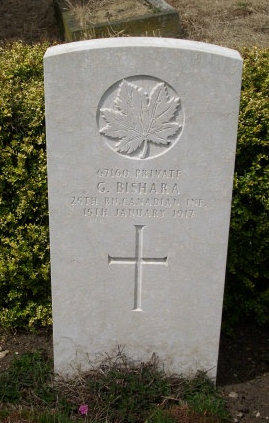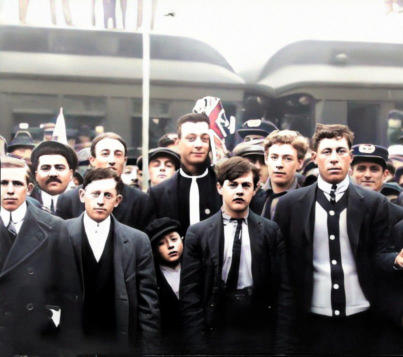
copyright © Wartime Heritage Association
Website hosting courtesy of Register.com - a web.com company
Wartime Heritage
ASSOCIATION
Remembering World War I
Yarmouth Connections

Name:
Gabriel (John) Bishara
Regimental number
67160
Rank:
Private
Service
25th Battalion
Date of Birth:
May 6, 1875
Place of Birth:
Mt Lebanon, Syria
Enlistment Date:
November 12, 1914
Enlisted at:
Halifax, Nova Scotia
Prior Military Experience:
Yarmouth NS Militia
Age at Enlistment:
39
Height:
5 Feet 8 Inches
Complexion:
Dark
Eye Colour:
Brown
Hair Colour:
Black/Grey
Martial Status:
Widower
Trade:
Merchant
Religion:
Roman Catholic
Next of Kin:
George Bishara (Brother) St John, New Brunswick
Date of Death:
January 15, 1917
Age at Death:
41
Cemetery:
Kensal Green (St. Mary's) Roman Catholic Cemetery, London, England
Grave Reference:
Canadian 3
Commemorated on Page 202 of the First World War Book of Remembrance
Displayed in the Memorial Chamber of the Peace Tower in Ottawa on May 8
Listed on the Nominal Roll of the 25th Battalion.
Listed on the Yarmouth War Memorial
Gabriel (John) Bishara enlisted with the 25th Battalion at Halifax on November 12, 1914 and trained
in Canada until May 20, 1915. He went overseas embarking Halifax on the SS Saxonia and arrived in
England on May 29, 1915. While at Shorncliffe Camp in England he injured his elbow and was treated
at Moore Barracks Canadian Hospital on July 19, 1915. He was hospitalized for twelve days at
Shornscliffe Military Hospital. On discharge on July 31, he returned to the 25th Battalion.
He embarked at Folkestone, Kent on September 15, 1915, and disembarked at Boulogne, France.
The 25th Battalion took part in the Battle of
Flers–Courcelette between September 15, 1916, and
September 22. During the battle the 25th Battalion came
under very heavy artillery fire from the German forces.
On September 17, Private Bishara suffered a serious
shrapnel wound to the jaw and was taken to No 13
Casualty Clearing Station at Boulogne. He was returned to
England and hospitalized at King George Hospital,London.
Word that he had been seriously wounded was first
received in Yarmouth in September 1916. A second
telegram was received in December 1916, stating that he
was seriously ill.
He was unable to speak due to his wounds and wrote
notes to his nurses. Private Bishara died on January 15,
1917, at 10:30 am and was buried at St Mary’s Catholic
Cemetery, Kensal Green, London on Thursday, January
18, 1917.
Gabriel (John) Bishara

Inductees at Dominion Atlantic Railway Station,
Yarmouth NS; (November, 1914)
John Bishara (1st on left, 2nd row)
[Florence Stopford was the daughter of Lorne E.
Baker of Yarmouth Nova Scotia and the wife of an
Admiral in the Royal Navy. She had visited Pte.
Bishara on several occasions and after his death
received the following letter]
King George’s Hospital
Ward G.B.
Stanford St., SE
January 15, 1917
Dear Mrs Stopford
I am sorry to have to tell you that Pte. Bishara
died this morning at 10:30. He had been getting
worse for some time and the end came quite quickly
and quietly,. His nephew was with him at the time.
I thought of you and that you would care to know as
you have been so good to him.
He is to have a military funeral from here
Thursday and will be buried at St. Mary’s Catholic
Cemetery, Kinsal Green, London.
Yours faithfully,
M. Weeden Cooke
Sister of George V Hospital 5
[Pte. Orbin VanTassel, of Digby NS, wrote home
to his parents Charles and Mary VanTassel in April
1916 and in that letter made reference to John
Bishara.]
I have seen John Bishara. He is here at the
front with the 25th. He told me to give you and
father his best regards. It is the same old John
but he is looking old.
...
[the following information is taken from the war
diary of the 25th Battalion]
On May 20, 1915, the 25th Battalion departed
Halifax on SS Saxonia after marching through the
City. They arrived in Portsmouth, England at 4:10
am on May 29, 1915.
The Battalion moved to Westenhanger , a
small village in south east Kent, near Folkestone.
The first parade in England was at East Sandling,
Kent on June 1, 1915. Between May 31 and
September 15, 1915 advanced training was
undertaken.
On Wednesday, September 15, 1915,
ammunition issued to each man (120 Rounds). The
Battalion left Camp at 6.30 P.M. arriving Folkstone
at 9 pm, leaving Folkstone at 10 pm an arriving in
Boulogne at 1 am September 16, 1915.
The 25th Battalion took over the trenches
from the 2nd Kings Own on the evening of the
September 22.
______________________________
The 25th Battalion took part in the Battle of
Flers–Courcelette between September 15, 1916
and September 22. During the battle tactical gains
were made in the capture of the villages of
Courcelette, Martinpuich and Flers.
During the battle the 25th Battalion came
under very heavy artillery fire from the German
forces.
The battle is significant for the first use of
the tank in warfare.





- World War I - Menu
- WWI Stories and Articles
- Photos - Yarmouth Soldiers
- Selection of World War I Songs
- WWI Casualties of Yarmouth, NS
- Those Who Served - Yarmouth, NS
- WWI Casualties Digby Co. NS
- WWI Casualties Shelburne Co. NS
- Merchant Mariners (1915) Yarmouth, NS
- Canadian Forestry Corps - Non Yarmouth Birth/Residence Enlistments
- US Draft Registry - Yarmouth NS Born


- World War II - Menu
- WWII Stories and Articles
- Telegraphist Air Gunners
- WWII Casualties of Nova Scotia
- US Casualties with NS Connection
- Far East/Pacific Casualties with NS Connection
- Merchant Navy Casualties Nova Scotia
- Nova Scotia WWII Casualties Holten Canadian War Cemetery
- D-Day Casualties - Nova Scotia
- CANLOAN Program Casualties - Nova Scotia
- Battle of the Bulge Casualties - Nova Scotia
- WWII Casualties Yarmouth NS
- Yarmouth Casualties - RCAF RAF Canadian Army WWII
- Yarmouth Co., Marriages WWII
- Casualties Non-Born/Residents with Connection to Yarmouth Co., Nova Scotia.
- WWII Casualties Digby Co., NS
- Non-Nova Scotian WWII Casualties Buried in Nova Scotia
- WWII RCAF Casualties Aged 16-18
- Brothers/Sisters Who Served - World War II













